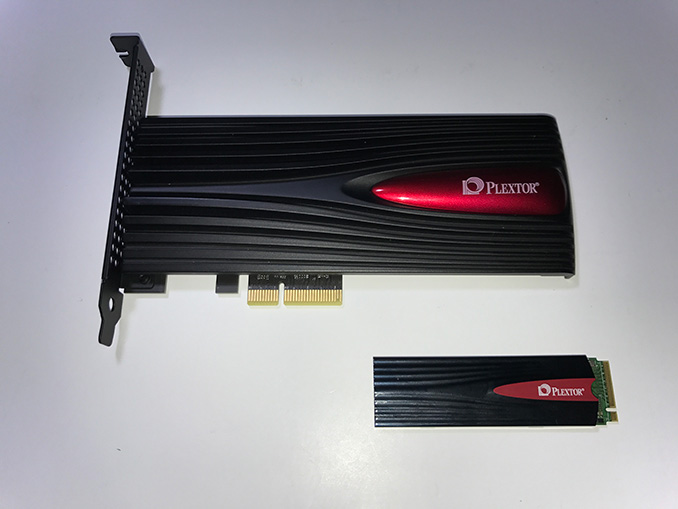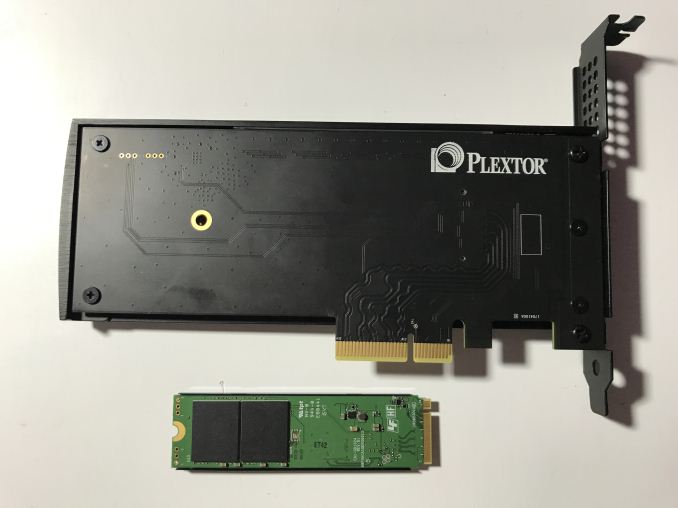Plextor Announces M9Pe SSD: 3.1 GB/s, Marvell Controller, 64-Layer 3D TLC, RGB LEDs
by Anton Shilov on June 2, 2017 10:00 AM EST- Posted in
- SSDs
- Marvell
- Plextor
- 3D NAND
- BiCS
- Computex 2017
- Plextor M9Pe

Plextor has announced its next-generation high-end SSD, the M9Pe. The new drive will use Toshiba’s 64-layer 3D TLC NAND memory and a Marvell controller, and will be available in configurations of up to 1 TB. Plextor says that it is planning to bring the drive to market by the end of this year.
When it comes to high-end SSDs Plextor has returned to its yearly update cycle, and at this Computex the company announced the successor of the M8Pe drive it launched 12 months ago: the M9Pe. Lite-On, the company behind Plextor SSDs, continued to work with Marvell and Toshiba, who supplied controllers and NAND for the previous-generation drives. For Plextor it is logical to keep the old relationship, especially given the shortage of flash memory on the market.
For the Plextor M9Pe, the manufacturer has chosen the Marvell 88SS1093 BTB2 controller as well as Toshiba’s 512 Gb BiCS 3D TLC NAND memory. The 88SS1093 BTB2 controller is equipped with three cores and features 8 NAND channels with 4 CE per channel (32 targets in total). The IC supports a Marvell’s third-generation ECC technology based on the LDPC algorithm and uses PCIe 3.0 x4 interface. Essentially the chip is an updated version of the 88SS1093 with higher frequencies and performance, which makes a lot of sense for higher-end SSDs. It is still an NVMe 1.1 IC, so do not expect any features of the latest NVMe 1.3 spec. Meanwhile, Plextor promises stable performance in sustained use cases, and this is what matters most.
Plextor will offer its M9Pe drives in 256 GB, 512 GB and 1 TB configurations. As for performance, we are looking at up to 3100 MB/s sequential read speed and around 2300 MB/s sequential write speed for the higher-end models, but as the numbers are preliminary; commercial devices might perform differently than the engineering samples the company is testing now. As for form-factors, Plextor plans to offer both an M.2 form-factor card with a radiator, as well as add-in-cards with a larger cooling system featuring RGB LEDs.
Plextor intends to bring its M9Pe drives to market by the end of the year. Pricing is something that is hard to tell today because it will depend on multiple factors, including competitive environment, and of course, where NAND prices are later this year.
Source: Plextor












41 Comments
View All Comments
ddriver - Friday, June 2, 2017 - link
Or explain how come day after day we have more and more obscure brands of SSDs popping out, offering no tangible benefits, reeking of "why even bother"? Why would NAND makers, who are all vertically integrated and aside from NAND also make SSDs, will be willing to sell their limited supply chips to third parties to generate profits?There are numerous hints that the NAND shortage is but a play for the public, and numerous indications that supply is actually ample. There is no shortage, just careful planning to keep supply tight, and not between OEMs and consumers, but between chipmakers and OEMs. That's a classic example of price gouging.
mischlep - Friday, June 2, 2017 - link
Companies are seeing that 2D NAND generation is not cost effective in the long run. The manufacturers are converting 2D NAND production capacity to 3D NAND production capacity. That production capcity will not be on-line until later in 2017.http://www.storagenewsletter.com/2017/03/10/nand-f...
SAMSUNG:
"For 4Q16, its NAND flash business registered a sequential growth of 11~15% for bit shipments and an increase of more than 5% in ASP. These results were attributed to strong demand for high-capacity eMMC, UFS and SSD products. Thus, Samsung's NAND flash revenue for the fourth quarter advanced by nearly 20% sequentially.
Looking at Samsung's production plans, the 2D- to 3D-NAND conversion at the Line 16 facility continues. Line 17 and the plant in Pyeongtaek, South Korea are designated for 3D-NAND production, but they are not expected to make significant contribution to Samsung's 3D-NAND capacity until after the second quarter of this year. Therefore, bit shipments for this first quarter will fall by around 4~9% compared with the previous quarter. If Samsung's plans proceed according to schedule, then its NAND flash bit shipments will again expand after the second quarter."
SK Hynix:
In 4Q16, SK Hynix scaled back SSD shipments while increasing eMCP shipments in response to the demand from Chinese smartphone brands. Consequently, the supplier's bit shipments for the quarter post a slight sequential drop of 3% but its ASP of NAND flash chips saw a large sequential hike of 14%. On the whole, NAND flash business grew its revenue by 9% sequentially in the fourth quarter, totaling around $1.16 billion.
Going into 1Q17, SK Hynix's NAND flash bit shipments will also be affected by the transition to 3D NAND as well as declining smartphone shipments during the period. The supplier's bit shipments could drop by around 5% sequentially. However, ASP of NAND flash chips is going to be on a steady rise due to the ongoing market undersupply.
With regard to SK Hynix's transition to 3D NAND, the advanced architecture is estimated to account for 10% of the supplier's bit shipments for the first quarter of 2017. The firm is currently releasing 48-layer products and will also be launching 72-layer products in the second half of this year.
Toshiba, WD, similar information...
Micron:
NAND flash revenue for Western Digital's 2FQ17 rose by about 20% sequentially due to increase in both bit shipments and ASP. The firm also continue to perform strongly in the SSD market, indicating that the company's acquisition of SanDisk has led to an effective integration of HDD and SSD lines.
In terms of product planning, Western Digital has already added its own branded 64-layer 3D NAND chips into its retail portfolio. Sampling of PC-OEM SSDs based on the same memory technology is also taking place in this first quarter. The share of 3D NAND products in the supplier's total NAND flash output is expected to exceed 50% by the end of 2017.
Intel:
Intel
Intel posted a large sequential increase of more than 25% for its NAND flash bit shipments in the fourth quarter of 2016 because of the high demand for enterprise-grade SSDs. The supplier's NAND flash revenue for the quarter also grew 25% sequentially to $816 million.
With regard to product planning, it will gradually scale down the production of its 20nm and 25nm products while increasing the weight of enterprise-grade SSD products based on both 3D NAND and MLC technologies. These 3D NAND MLC SSDs can be priced competitively and help Intel improve the overall cost structure and profitability. At the same time, the firm is now starting the mass production of 3D NAND TLC products.
sleepeeg3 - Friday, June 2, 2017 - link
I think the whole hypothetical argument is stupid, but for the record, there has been collusion with the memory companies in the past to fix prices. Multiple times.https://www.law360.com/competition/articles/5518/h...
https://www.law360.com/articles/336763/sandisk-cut...
It's within the realm of possibility that price fixing is indeed going on, but unless someone has proof, it is pointless to speculate on it. The prices are either worth buying to you or they are not. Vote with your wallet.
woggs - Friday, June 2, 2017 - link
OMG. The demand is from ENTERPRISE customers for ENTERPRISE drives.lmcd - Friday, June 2, 2017 - link
Do you not get how econ works? Higher prices = lower demand at the price point.Mikewind Dale - Saturday, June 3, 2017 - link
ddrive, you're mixing up two different definitions of "shortage". Right there, there is a NAND shortage in a colloquial, non-economic sense, simply meaning that NAND is scarce, and that there is not as much NAND as we'd like there to be. In this sense, there is a shortage of almost all goods, because we'd always like there to be more of everything. So when we say that there is a NAND shortage, we simply mean that the supply of NAND is less than what we are accustomed to its being. (The most likely reason is that NAND fabs are retooling to transition from planar to 3D NAND, so in the meantime, there has been a negative supply shock.)On the other hand, when you discuss an SSD shortage, you silently switch you a different definition of shortage, viz. the economic definition. In economics, "shortage" refers to when the quantity demanded exceeds the quantity supplied ***at a given price***. You are assuming the price is given, and you are saying that the shelves are well-stocked. Well, this just means that the price is right.
For example, suppose a new 1 TB SSD cost only $100. We'd find a ton of willing buyers, but almost no willing sellers. That would be a shortage. But when the price rises to say $1,000, we find an equal number of buyers and sellers, and the market clears without incident. You're saying that SSDs are in stock, and so there is no shortage. Well, this just means that the price is apparently being set efficiently, so that quantity demanded equals quantity supplied (over some reasonable span of time).
Now, suppose the price of NAND skyrocketed, and so the price of SSDs skyrocketed as well. But suppose that the shelves remained well-stocked. This would mean there was a shortage in the colloquial sense of "not as much as we'd like", but NOT a shortage in the economic sense of "the price is equating supply and demand".
DanNeely - Friday, June 2, 2017 - link
An increase of supply well in excess of the expected future demand will cause a price crash. Textbook disruption right there.Lord of the Bored - Thursday, June 8, 2017 - link
I'd like you to substantiate YOUR claims with fact. Where is your evidence of artificial scarcity and a global conspiracy to fix prices? Extraordinary claims require extraordinary evidence, so the burden of proof is on you as the party with the more outlandish claim.I am not saying it is impossible. My memory IS long enough to remember when the SRAM manufacturers got nailed for conspiring to keep prices artificially high. But... your certainty speaks of either foolishness or ironclad evidence, and we would ALL like to see your evidence.
Mikewind Dale - Saturday, June 3, 2017 - link
Reducing supply will increase profits only for a monopolist. If you think that a NAND producer is behaving this way, then you are implicitly asserting that there is a single monopolistic NAND producer, or else that all of the NAND producers have successfully formed a monopolistic cartel amongst themselves, so that they no longer compete with each other.I think that both possibilities are highly dubious. Therefore, it is more likely that the NAND industry is competitive, and that the the scarcity is natural, not artificial.
Mikewind Dale - Saturday, June 3, 2017 - link
Incidentally, this time-lag in retooling factories to produce 3D instead of planar, and the disruption to the industry caused by this time-lag, is a great illustration of Ludwig Lachmann's claim, in Capital and Its Structure, that capital is not a generic lump of clay that can be costlessly and instantly reallocated, the way some macroeconomists imagine. Instead, Lachmann says, capital is heterogeneous and multi-specific - meaning, that capital equipment can be used for multiple purposes, but not for infinite purposes, and that any given piece of capital equipment is better-suited for some purposes than others.